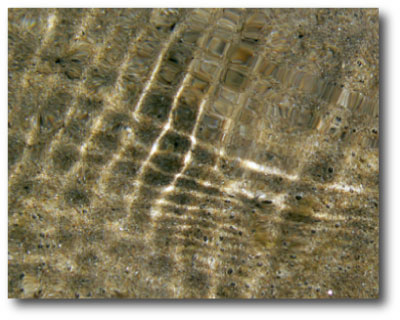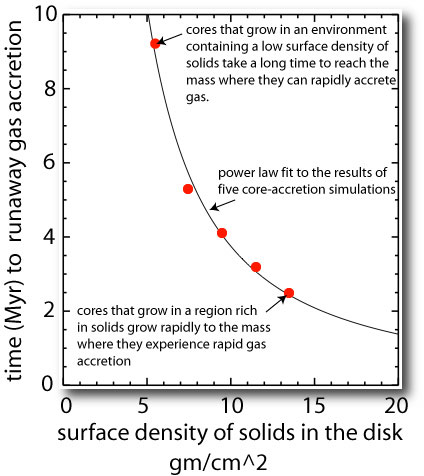
Image source.
Four out of five astrophysicists surveyed recommend the core-accretion theory to those interested in planet formation theories.
Oklo regulars know that I lean toward core-accretion over gravitational instability as an explanation of the dominant mode of planet formation. I think that core-accretion does a superb job of explaining the planet-metallicity connection, and I don’t think that the initial conditions that underlie hydrodynamical calculations that show disk fragmentation are physically realistic.
The key aspect of core-accretion is that it is a threshold phenomenon. If a planetary core reaches a Neptune-like mass of ~10-20 Earth masses while there is still gas in the protoplanetary disk, then it will rapidly accrete that gas, and (in most cases) increase its mass by a factor of ten or more. On the other hand, if a core reaches a Neptune mass after the gas is gone, then the growth will cut off, and the core will end its days as a modest ice giant.
The amount of time that it takes for a core to reach the phase of rapid gas accretion depends sensitively on the amount of solid material that is available in the disk in the form of planetesimals. A disk with a high surface density of solids is capable of rapidly assembling a core, thereby forming a Jovian-mass gas giant quite quickly. Recent simulations suggest that an average protostellar disk surrounding a star of solar metallicity will lie right at the threshold of being able to manufacture a Jovian planet. This result gives a satisfying mesh with the observations. As stellar metallicity exceeds solar, the fraction of stars with detectable Jovian-mass planets increases very rapidly. Disks that form their Jovian planets early-on are better able to migrate them into the terrestrial region where they can easily be detected. Stars of solar mass and metallicity will tend to have giant planets that remained, like Jupiter, more or less where they formed. Stars with subsolar metallicity will rarely be accompanied by Jupiter-mass planets.

In addition to explaining the planet-metallicity connection, core-accretion provides a number of other testable predictions. Our simulations suggest that a growing planet orbiting a star with 40 percent of the Sun’s mass will require more than 10 million years to “go Jovian.” After 10 million years, however, the gas in most protostellar disks is long gone. The core-accretion theory predicts, therefore, that low-mass red dwarf stars should very often be accompanied by Neptune-mass planets but should almost never have Jupiter-mass companions.
The surface density of solids in a protostellar disk is correlated with metallicity, and some heavy elements are more important than others. Oxygen, for example, in the form of water ice, is of fundamental importance for building cores. At given mass and overall metallicity, therefore, a disk that is naturally rich in oxygen should be better able to form Jupiter-mass planets. Silicon-rich disks too, should have an enhanced capacity for building gas giants.

Hi all ! :-D
Thanks for this post, Greg ;-) .
With this model, the stellar metallicity seems to have an influence on the forming of planets.
You said : “Stars with subsolar metallicity will rarely be accompanied by Jupiter-mass planets.”
My question : Could the forming of low-mass terrestrial planets(like Earth, Mars etc…) be conditioned by the stellar metallicity ?
From time to time, I say to myself that stars with a high metallicity would not be good candidates to look (in the future) terrestrial planets…
For example, 55 Cancri may have only jovian and neptunian planets !
What do you think about it?
Thanks.
Would carbon-rich discs like the one(s) around Beta Pictoris promote or inhibit gas giant formation?
Also, what’s the thinking on forming the planet of PSR 1620-26 in a low-metallicity environment?
Pingback: systemic - Pollux
Hi Vincent,
Thanks for your question. Terrestrial planet formation should not be adversely affected until the metallicity gets really low. Stars in our Galaxy’s globular clusters, for example, often have only about 1% of the Sun’s metal content, and I would expect that the terrestrial planets around these stars are pretty low mass. For stars of, say, half solar metallicity, however, there should be plenty of habitable terrestrial planets.
And you’re right as well about the high-metallicity systems as well. When you have off-the-hook planet formation, the migration of the Jovian-mass planets through the terrestrial region is going to likely clear things out and make the formation of habitable worlds less likely.
best,
Greg
Hi Andy,
Thanks for your question as well!
The carbon-rich dust and debris orbiting Beta Pic might be more indicative of chemical processing in the ices of the outer regions of Beta Pic’s protoplanetary disk. It is true, however, that carbon will be an important core-forming element, and that a carbon-rich nebula might have an advantage in Jovian planet formation. We’ve been interested in the role of silicon as a proxy for oxygen (see the upcoming posts) but as the number of planets and surveyed stars increases, it would be interesting to do a statistical analysis of planet occurence as a function of carbon abundance of the parent star. That is, the effect is probably there, but its probably subtle.
I’d rather sweep the PSR 1620-26 planet under the rug :). In all seriousness, though, there’s no way that planet formed via core accretion, so it must be the result of gravitational instability. I better go and look at the papers on that planet, and I’ll check back later if I can think of anything interesting to say about it. (I didn’t pay much attention to it when it was announced.)
best,
Greg